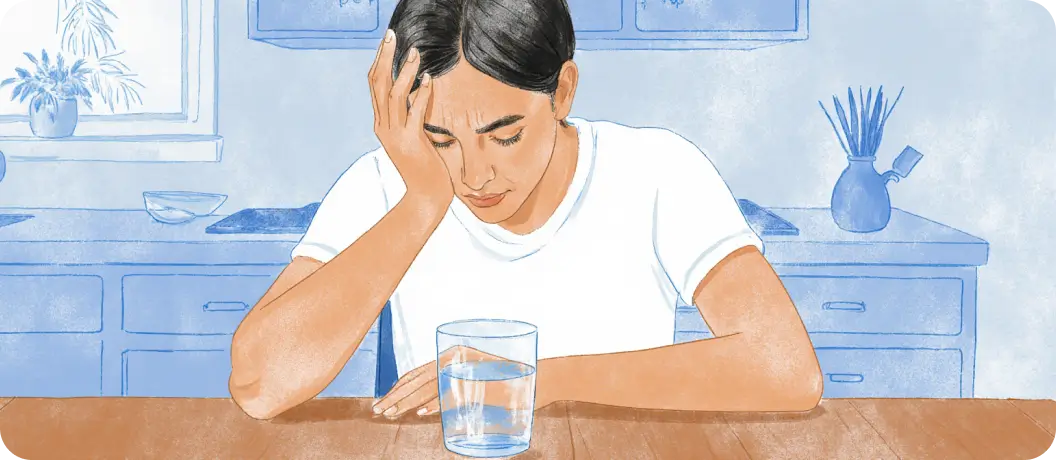Researchers prove that it helps release stress and eases pain. [1] As such, you don’t always need to look for ways to stop your tears, so you might give yourself time to process the situation and let them go.
Nevertheless, if you find yourself dealing with uncontrollable crying or have a hard time keeping yourself calm when you need it, here’s how to regain control.
Frequent crying can stem from underlying problems and unprocessed emotions. Find out what’s hidden behind by taking a quick & free test.
14 tips on how to stop crying episodes
Please pay attention that these strategies are helpful for moments when you need to pause intense emotions. But giving yourself space to fully feel and process emotions, like crying, is also a valid and healing experience.
1. Blink rapidly for 15–20 seconds
Some people find blinking rapidly helpful for stopping tears. This might be because this process clears tears from the eyes and allows you to refocus attention. Such a simple action can interrupt the flow and calm your mind during intense human emotional crying.
It can be even more effective in combination with other coping mechanisms. While blinking rapidly provides immediate distraction, affirmations, deep breathing, or active movement can help you completely calm down.
2. Fidget with something to stop excessive crying
Fidgeting can help you cope with the urge to cry and get more grounded if the tears have already started. Here’s what you can try:
- Hold and squeeze a stress ball or plush toy
- Fidget with a pen or pencil
- Rub a textured surface
- Roll a coin or ring between your fingers
- Tap your fingertips together or lightly drum on a surface
3. 4-7-8 breathing exercises
According to a study published in Brain Sciences, breathing exercises can reduce stress and anxiety while helping you handle intense emotions. [2]
- Inhale deeply for 4 seconds
- Hold your breath for 7 seconds
- Exhale slowly for 8 seconds
4. Diaphragmatic breathing
- Sit or lie down comfortably
- Put one hand on your belly
- Start taking deep breaths through your nose
- Let your stomach rise and observe it calmly
- Practice for at least a few minutes or until you reach a calm emotional state
5. Pursed-lip breathing
- Inhale gently through your nose for 2 seconds
- Purse your lips as if you’re going to whistle
- Exhale through your pursed lips for 4 seconds
- Repeat several times to slow your breathing and relax
6. Physiological sigh
- Take a deep breath through your nose
- Immediately take the second, smaller inhale
- Breathe out slowly through your mouth
- Repeat a few times
Have you ever tried breathing exercises to calm down?
7. Recite grounding affirmations
Among the causes of adult emotional crying might be an inability to cope with what’s happening around. When the world feels overwhelming and seems like you can’t handle anything, it might be helpful to pause and repeat something inspiring. Save these affirmations, or get a daily affirmation in the Breeze app, or create a list of your comforting phrases.
- “I am safe and I can cope with my feelings.”
- “This too shall pass.”
- “This moment doesn’t define me.”
- “I am allowed to feel and seek support.”
- “All people cry, and it’s a natural way to release emotions.”
When chronic stress takes over, you can stand in front of the mirror and repeat these affirmations out loud. Also, you can write them down and keep them somewhere visible (for instance, on your desk or as your phone wallpaper). This way, you’ll feel empowered even in tough moments.
Find out how well you recognize your emotions and learn what drives your crying episodes with tailored insights from Breeze.
8. Stop crying spells with cold water
Crying might be your emotional response to a certain situation. To calm down, you may need to concentrate on something completely different. Cold water lets you focus on your body instead of the thought process. If it feels okay for you, you can try to:
- Splash it on your face
- Rinse your hands under a stream of cold water
- Hold a cool compress against your cheeks
- Drink a glass of cold water

9. Do something active
This doesn’t necessarily mean that you need to hit the gym or go for a run. Physical activity can help you shift focus, no matter how intensive it is. The study has proven that movement allows a sense of freedom, provides a distraction, and serves as an escape from grief. [3]
So even if you don’t know how to handle emotional distress, moving your body can be the first step for calming your mind. Additionally, you can:
- Go out, get some fresh air, and take a short walk
- Do light stretching exercises
- Clean your room to feel more in control
- Do a 5‑minute guided yoga
- Water your plants
10. Channel your feelings into emotional expression
If you need to release emotions but want to avoid excessive crying, it may be a good idea to express them differently. Try some of the following:
- Write down how you feel and what makes you nervous or frustrated
- Engage in drawing or coloring
- Talk to a friend or family member about what’s on your mind
- Record yourself talking about your feelings
Please note that this isn’t always a way to avoid emotional tears. Sometimes crying is necessary, and holding it back all the time might be unhelpful. Still, these options can help when you want to manage your emotions in other ways.
Expert Insight
“Emotional expression techniques can help reduce the frequency and intensity of crying spells over time by offering safe and constructive outlets for overwhelming feelings. When emotions are consistently suppressed or left unprocessed, they can build up and surface unexpectedly, often through crying. Practices like journaling, art, movement, or talking to a trusted person give emotions a place to go, which supports nervous system regulation. Over time, these techniques can build emotional literacy and resilience, helping individuals better understand and respond to their internal states. That said, crying itself is not a problem to fix; it’s a natural release, and the goal is to expand emotional capacity, not eliminate tears altogether.”
Abigail Fernald
Mental health professional
11. Progressive muscle relaxation technique
Returning to the present moment and practicing mindfulness exercises can be another way to stop uncontrollable crying. Listening to your body and its physiological responses is a perfect way to calm your nervous system. Try this simple exercise:
- Sit or lie down comfortably.
- Focus on your toes: tense them for a few seconds and then release.
- Notice how your muscles feel and then move up.
- Tense and relax your legs, stomach, arms, neck, and facial muscles.
- Spend a few more minutes noticing how your body feels.
12. Describing objects (grounding technique)
If you’ve only started crying or want to stop crying spells, this approach can work anywhere and serve as a way to shift focus. You only need to:
- Choose any object around you and take a closer look at it.
- Start describing it in as much detail as possible: its color, shape, size, texture, and how it might feel to touch.
- You can say the description out loud or silently in your head if you’re not alone.
- If your mind starts wandering and thinking about crying, bring it back to describing the object.
13. Breeze to cope with negative emotions
The Breeze app can be your go-to companion to restore balance and quickly stop crying wherever you are. Here are the main features you can use to feel better.
Relaxation games
When crying spells feel overwhelming, you can concentrate on something more pleasant. Engage in guided breathing, try the flower chain game, or listen to calming waters. Even simple, playful activities can bring a sense of safety and remind you that the moment shouldn’t be so heavy.
Journaling
Whether you need to take care of your emotional wellness or stop uncontrollable crying at the moment, journaling about what you feel may be a good idea for releasing tension. Breeze allows you to calm down when you feel worried or anxious and foster gratitude with well-defined journaling prompts. This will let you analyze your emotional response to the situation and understand its deeper cause.
Mood tracker
There might also be one repeating situation that makes you cry or feel stressed (for instance, problems at work or conflicts with your partner). While this isn’t the way to calm down on the spot, Breeze’s mood tracker can help you notice such patterns and look for ways to avoid them in the future.

14. Get a mental health professional’s support
Finally, if uncontrollable crying episodes happen regularly, this might be caused by something more serious than just releasing emotions after a hard day. There are several mental health conditions and states that can make you cry regularly or, on the other hand, make you unable to cry even when you want to.
- Depression
- Anxiety disorders
- Hormonal imbalances
- Physical exhaustion or burnout
- Unresolved childhood trauma
All of them require support from a mental health professional or another qualified specialist who can help you identify the issue and develop effective coping strategies to handle symptoms in the long run.
Adjustment disorder & emotional tears
There’s also one more mental health condition that you should know about if your daily life is full of extreme reactions.
Adjustment disorder is a mental health condition that means having a hard time coping with a stressful event. The reaction is stronger or lasts longer than what can typically be expected for the specific situation. [4]
This means that a person may experience even a minor life challenge (like getting a bad mark for the exam or having an argument with a friend), but it may lead to prolonged grief and strong emotional responses. These can include:
- suicidal thoughts
- self-harm
- depressive episodes
- self-esteem problems
- feeling unhappy
- uncontrollable crying, etc.
If you’re experiencing suicidal thoughts or self-harming behaviors, please reach out to a crisis line (988 in the United States) or licensed mental health professional right away. You don’t have to go through it alone. Support is available, and you deserve care.
Adjustment disorder may develop after experiencing big challenges or stressful events (e.g., a significant loss). While this mental health issue can go on its own, it’s better to contact a professional to develop the skills to handle tough emotions faster. At the same time, it should last longer than 6 months after the event’s consequences are resolved. [5]
What’s the difference between adjustment disorder and depression when it comes to uncontrollable crying? Abigail Fernald, LCSW, answers, “While both adjustment disorder and depression can involve uncontrollable crying, the root causes and duration of symptoms often differ. Adjustment disorder is typically triggered by a specific life event or stressor, such as a breakup, job loss, or major transition, and the emotional response is typically considered more intense than expected for the situation. In contrast, depression is a clinical mood disorder that may not be linked to a single event and tends to involve persistent sadness, low energy, loss of interest, and changes in sleep or appetite over a longer period. Crying in adjustment disorder often resolves as the person adapts to the stressor or receives support, whereas in depression, crying may feel more constant, unexplained, or emotionally blunted. A mental health professional can help determine the underlying cause and provide appropriate treatment and support.”
Sources
- Rendeza, Karen. “TURNING WEAKNESS INTO STRENGTH: THE BENEFITS OF SHEDDING EMOTIONAL TEARS. PEOPLE: International Journal of Social Sciences.” PEOPLE International Journal of Social Sciences. 2018
- Bentley TGK, D’Andrea-Penna G, Rakic M, Arce N, LaFaille M, Berman R, Cooley K, Sprimont P. “Breathing Practices for Stress and Anxiety Reduction: Conceptual Framework of Implementation Guidelines Based on a Systematic Review of the Published Literature.” Brain Sci. 2023
- Williams J, Shorter GW, Howlett N, Zakrzewski-Fruer J, Chater AM. “Can Physical Activity Support Grief Outcomes in Individuals Who Have Been Bereaved? A Systematic Review.” Sports Med Open. 2021
- American Psychiatric Association. “Diagnostic and Statistical Manual of Mental Disorders (DSM-5®) 5th ed.” American Psychiatric Association Publishing; Washington, DC, USA: 2013. Trauma- and stressor-related disorders.
- O’Donnell ML, Agathos JA, Metcalf O, Gibson K, Lau W. “Adjustment Disorder: Current Developments and Future Directions.” Int J Environ Res Public Health. 2019
Disclaimer
This article is for general informative and self-discovery purposes only. It should not replace expert guidance from professionals.
Any action you take in response to the information in this article, whether directly or indirectly, is solely your responsibility and is done at your own risk. Breeze content team and its mental health experts disclaim any liability, loss, or risk, personal, professional, or otherwise, which may result from the use and/or application of any content.
Always consult your doctor or other certified health practitioner with any medical questions or concerns
Breeze articles exclusively cite trusted sources, such as academic research institutions and medical associations, including research and studies from PubMed, ResearchGate, or similar databases. Examine our subject-matter editors and editorial process to see how we verify facts and maintain the accuracy, reliability, and trustworthiness of our material.
Was this article helpful?







